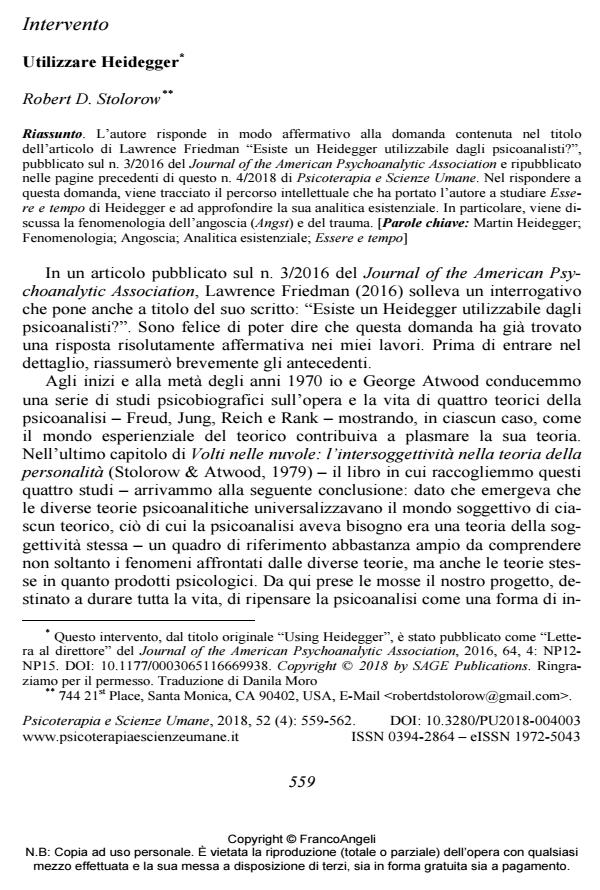Intervento. Utilizzare Heidegger
Journal title PSICOTERAPIA E SCIENZE UMANE
Author/s Robert D. Stolorow
Publishing Year 2018 Issue 2018/4
Language Italian Pages 4 P. 559-562 File size 33 KB
DOI 10.3280/PU2018-004003
DOI is like a bar code for intellectual property: to have more infomation
click here
Below, you can see the article first page
If you want to buy this article in PDF format, you can do it, following the instructions to buy download credits

FrancoAngeli is member of Publishers International Linking Association, Inc (PILA), a not-for-profit association which run the CrossRef service enabling links to and from online scholarly content.
L’autore risponde in modo affermativo alla domanda contenuta nel titolo dell’articolo di Lawrence Friedman "Esiste un Heidegger utilizzabile dagli psicoanalisti?", pubblicato sul n. 3/2016 del Journal of the American Psychoanalytic Association e ripubblicato nelle pagine precedenti di questo n. 4/2018 di Psicoterapia e Scienze Umane. Nel rispondere a questa domanda, viene tracciato il percorso intellettuale che ha portato l’autore a studiare Essere e tempo di Heidegger e ad approfondire la sua analitica esistenziale. In particolare, viene discussa la fenomenologia dell’angoscia (Angst) e del trauma.
Keywords: Martin Heidegger; Fenomenologia; Angoscia; Analitica esistenziale; Essere e tempo
- Heidegger M. (1927). Sein und Zeit. Jahrbuch für Philosophie und phänomenologische Forschung, VIII: 1-438; Sein und Zeit. Tübingen: Niemayer, 1927 (trad. it.: Essere e tempo. Milano: Longanesi, 1970).
- Orange D.M., Stolorow R.D. & Atwood G.E. (1997). Working Intersubjectively: Contextualism in Psychoanalytic Practice. Hillsdale, NJ: Analytic Press (trad. it.: Intersoggettività e lavoro clinico: il contestualismo nella pratica psicoanalitica. Milano: Raffaello Cortina, 1999).
- Stolorow R.D. (1999). The phenomenology of trauma and the absolutisms of everyday life: A personal journey. Psychoanalytic Psychology, 16, 3: 464-468. DOI: 10.1037/0736-9735.16.3.464
- Stolorow R.D. (2007). Trauma and Human Existence: Autobiographical, Psychoanalytic, and Philosophical Reflections. New York: Routledge (trad. it.: Trauma ed esistenza umana: riflessioni autobiografiche, psicoanalitiche e filosofiche. Roma: Fioriti, 2013).
- Stolorow R.D. (2011). World, Affectivity, Trauma: Heidegger and Post-Cartesian Psychoanalysis. New York: Routledge.
- Stolorow R.D. (2013). Heidegger and post-Cartesian psychoanalysis. In: Raffoul F. & Nelson E., editors, The Bloomsbury Companion to Heidegger. London: Bloomsbury Academic, 2013, pp. 451-458.
- Stolorow R.D. & Atwood G.E. (1979). Faces in a Cloud: Subjectivity in Personality Theory. New York: Aronson (trad. it. Volti nelle nuvole: l’intersoggettività nella teoria della personalità. Roma: Borla, 2001).
- Stolorow R.D. & Atwood G.E. (1992). Contexts of Being: The Intersubjective Foundations of Psychological Life. Hillsdale, NJ: Analytic Press (trad. it.: I contesti dell’essere: le basi intersoggettive della vita psichica. Torino : Bollati Boringhieri, 1995).
- Stolorow R.D., Brandchft B. & Atwood G.E., editors (1994). The Intersubjective Perspective. Northvale, NJ: Aronson (trad. it.: La prospettiva intersoggettiva. Roma: Borla, 1996).
- Stolorow R.D., Brandchft B., Atwood G.E., Fosshage J. & Lachmann F. (1999). Psicopatologia intersoggettiva. A cura di Marco Casonato. Urbino: Quattroventi.
Robert D. Stolorow, Intervento. Utilizzare Heidegger in "PSICOTERAPIA E SCIENZE UMANE" 4/2018, pp 559-562, DOI: 10.3280/PU2018-004003